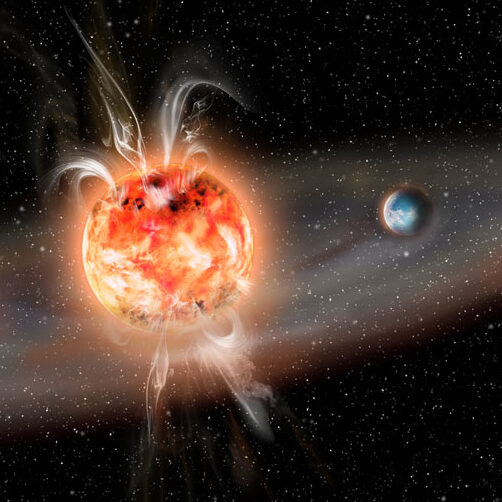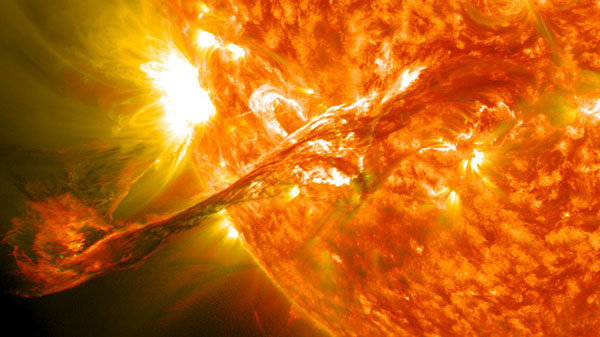Red dwarf stars appear to flare preferentially at high latitudes, which might keep their exoplanets habitable instead of hellish.
Astronomers have found that the most common stars in the galaxy might not be as perilous as once thought, making way for more potentially habitable exoplanets. The results will appear in the Monthly Notices of the Royal Astronomical Society (preprint available here).
Red dwarf stars — also known as M dwarfs — comprise about 75% of all stars in the Milky Way. They’re much cooler and smaller than the Sun and, since some of them lack the internal layers that Sun-like stars have, their churning guts and fast rotation make them prone to extreme magnetic activity, such as flares. Flares occur when the stellar magnetic fields get twisted up and then snap back into alignment, exerting high-energy radiation in the process.

Astronomers used to worry that the radiation and particles from super-powered flares might strip these stars' planets of atmosphere, making them uninhabitable. The potentially habitable planets around cool M dwarfs are in a particularly vulnerable position, because they must orbit close to the star to be in its habitable zone, where water could remain liquid on a rocky surface.
Now, a team lead by Ekaterina Ilin (Leibniz Institute for Astrophysics Potsdam, Germany) presents evidence that flares might not be so destructive after all. Ilin’s team combed through data from NASA’s Transiting Exoplanet Survey Satellite (TESS), searching for M dwarf superflares that last longer than the rotation period of the star. They found four of these flaring stars — and their flares all occurred at high latitudes, near the poles. These locations are surprising because they’re unlike the sites of solar flares, which are found near the Sun’s equator. The harmful radiation from high-latitude flares would miss prospective planets, allowing them to retain their atmospheres.
Polar Flares
Ilin’s team studied the M dwarfs by inspecting their light curves, which show how a star changes in brightness over time. At the onset of a flare, the light curve shows a big spike in brightness. Since these flares lasted longer than the star’s rotation period, the spinning of the star alters the flare’s signature, leaving a rotational fingerprint that enabled Ilin’s team to pinpoint its location on the star’s globe.
The flares occurred between 55° to 81° in latitude, farther from the stars’ equators than the Sun would have allowed. Solar flares, as a general rule, occur within 30° of the equator.

NASA / GSFC / SDO
Although Ilin’s team only finds four of these high-latitude-flaring stars, Cynthia Froning (University of Texas, Austin), who was not involved in the study, thinks the results are significant. The team shows that if flares were equally likely to happen at all latitudes, they would have seen them there — statistically speaking, there’s only a 1 in 1,000 chance that they would have found all the flares at high latitudes if this was not the norm for red dwarfs.
Potentially Habitable Planets
If M dwarf flares typically occur at high latitudes, planets that orbit in the plane of the star’s equator — which is the case for planets around such stars where inclinations are known — will never encounter the outbursts of energetic particles.
However, a polar flare may not completely relieve exoplanets from harm’s way — Ilin’s team studies flares in visible light, but higher-energy ultraviolet and X-ray radiation might not act the same.
“This is significant as it is the high-energy flux that drives much of the heating in exoplanet atmospheres,” says Froning, and that heating and its consequences are what might dissipate atmospheres. However, if this higher-energy radiation flows from the poles along with the visible light, or becomes trapped inside the star’s strong magnetic field, planets could still be safe.
As TESS continues to scan the sky, it will observe more long-duration flares and confirm whether red dwarf eruptions really favor high altitudes. Perhaps the most common stars in the galaxy could host habitable planets after all.
 4
4









Comments
Tom Kellogg
August 12, 2021 at 10:57 pm
Thanks Lauren for the fascinating news. Since red dwarfs have the longest life spans of all types of stars this is especially promising to have13 billion years during which life could evolve in such planetary systems. 75% of all stars are red dwarfs and most red dwarfs are older than heavier stars leads to a much higher likelihood of finding life there.
You must be logged in to post a comment.
GerryH
August 16, 2021 at 4:32 am
Hi Tom,
There is very little likelihood of finding life around old red dwarf stars, as the heavy elements needed for even a solid surface, let alone life, were not yet synthasized by supernovae at that epoch
Just a thought
Gerry
You must be logged in to post a comment.
arap tuga
August 17, 2021 at 10:47 am
Gerry, "older than heavier stars" still leaves a lot of wiggle room for relatively metal-rich red dwarfs. Not 13 By, admittedly, but perhaps ten billion or so. This could - IF confirmed - open up most of the stars in the universe as potential sites for life.
You must be logged in to post a comment.
Martian-Bachelor
August 25, 2021 at 1:22 pm
Because their absolute luminosities are so small relative to an F, G, or K main sequence star, M dwarfs have very small Goldilocks zones, so I'm not sure if their numbers make up for that even if these zones turn out to be unaffected by the stars' flare activity.
Hopefully the sample size can be greatly increased in the future, because four stars isn't much to go on. Just a better understanding of these star's structure, atmospheres, and activity is enough reason to study them, irrespective of any possible planets in habitable zones.
You must be logged in to post a comment.
You must be logged in to post a comment.